Abstract
IgG anti-IgE autoantibodies in human allergic sera have been investigated using an enzyme immunoassay on microplates coated with anti-human IgE MoAb. After incubation with serum, the plates were developed with peroxidase-labelled anti-human IgE MoAb for the determination of total IgE levels, or with anti-IgG MoAb for evaluating IgG anti-IgE autoantibodies. Using this methodology, no correlation was found between total IgE and IgG anti-IgE levels in groups of sera of allergic individuals. Although the results obtained with enzyme-labelled anti-IgG are often interpreted as indicative of IgE-IgG complexes captured from the serum, molecular sieving on gel columns as well as direct ultrafiltration experiments through 300-kD membranes demonstrate that such complexes do not occur preformed in the circulation, but arise de novo on the anti-IgE-coated solid phase during in vitro incubation with human serum. It is suggested that IgG anti-IgE autoantibodies react with IgE only after the latter has undergone a conformational change, either by colloidal manipulation or after reaction with allergen.
Full text
PDF
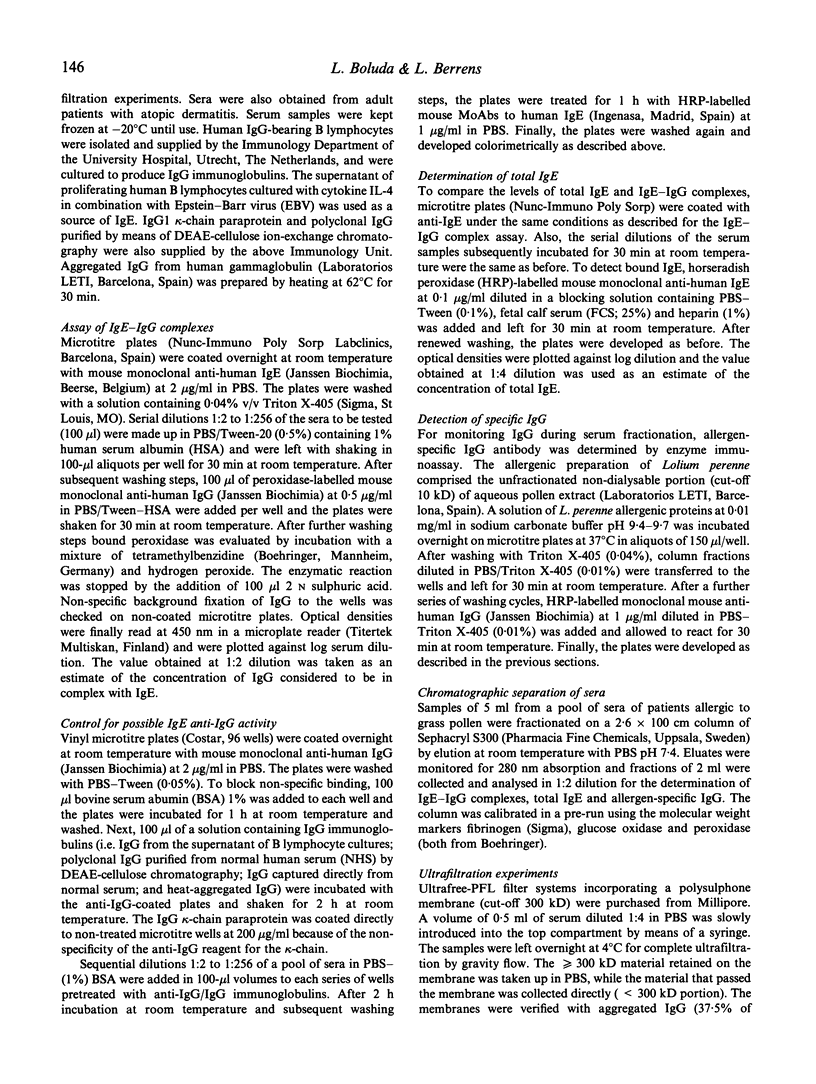
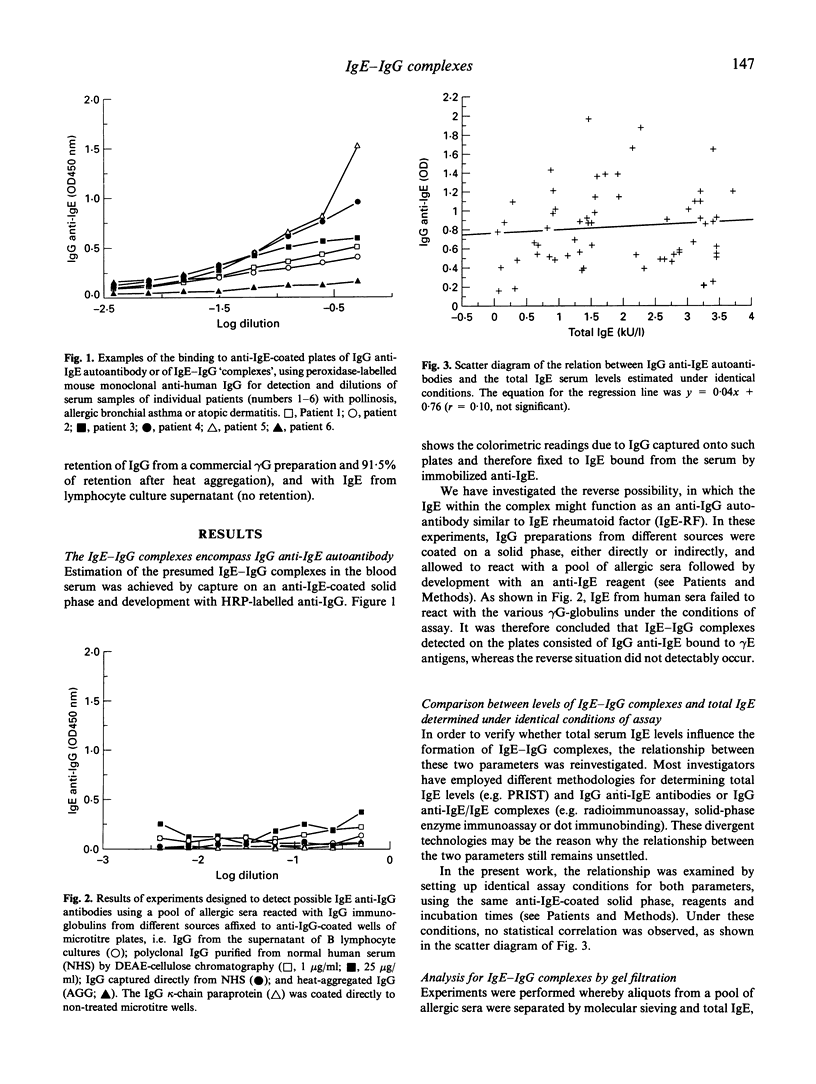
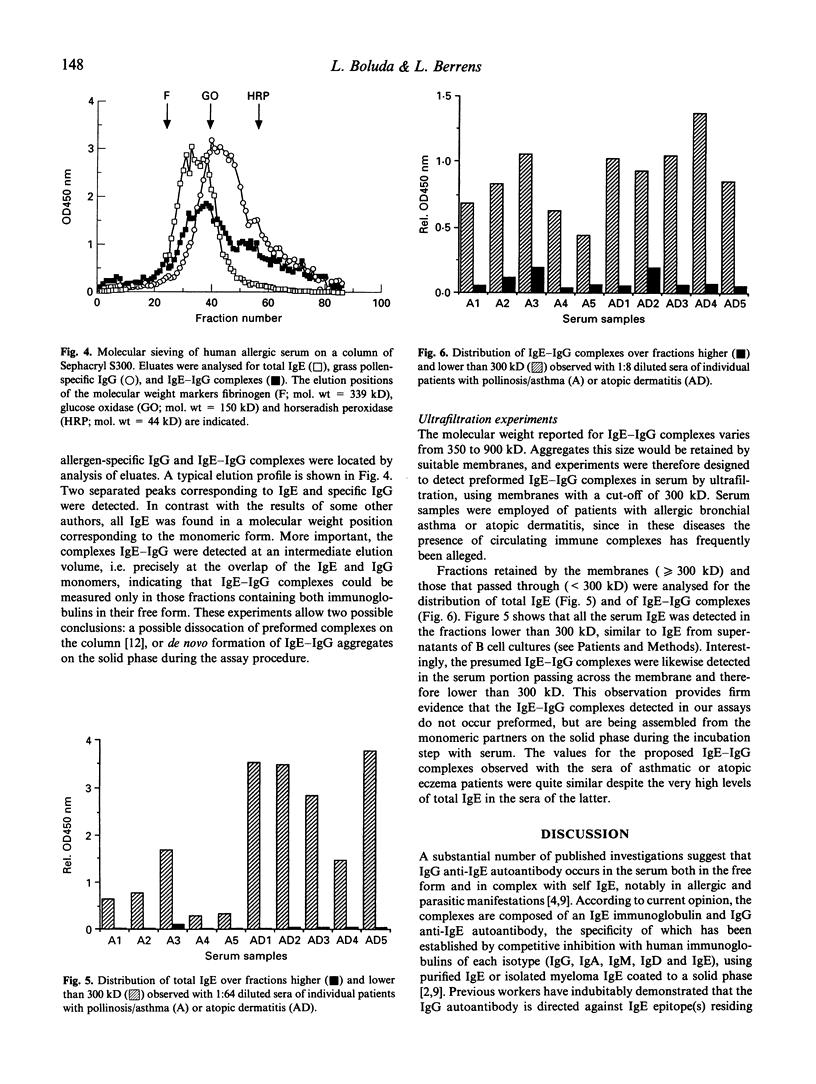
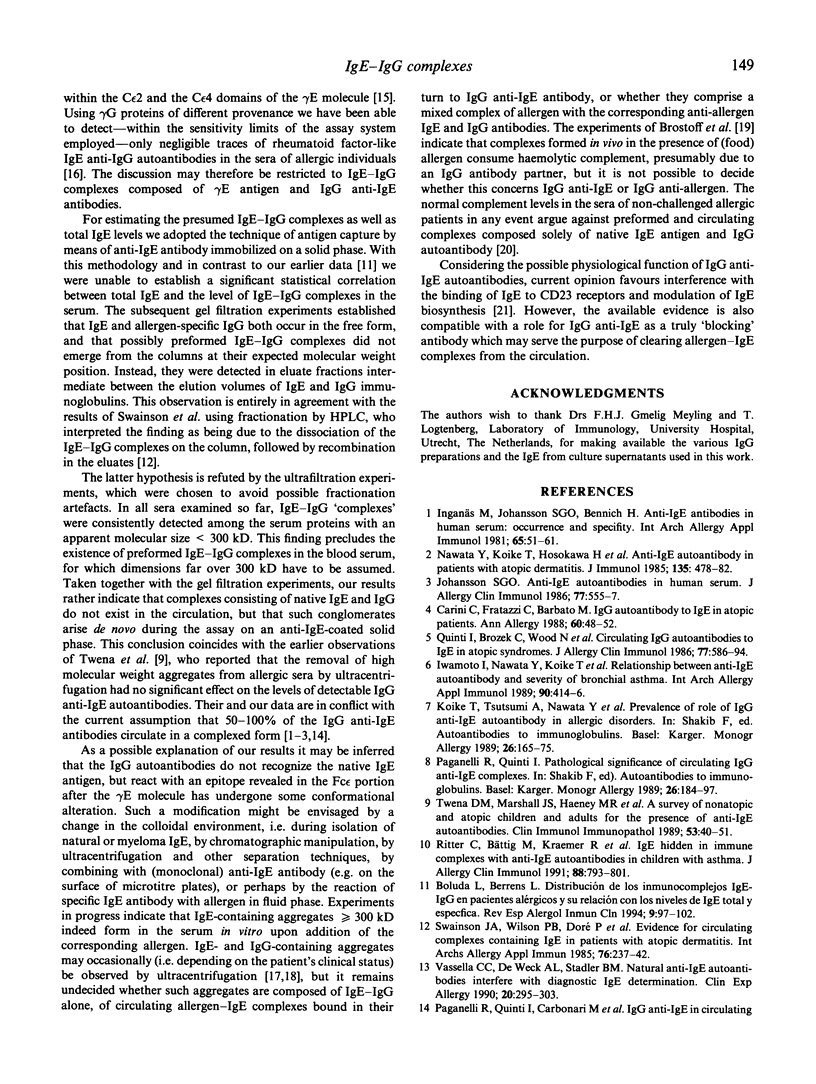
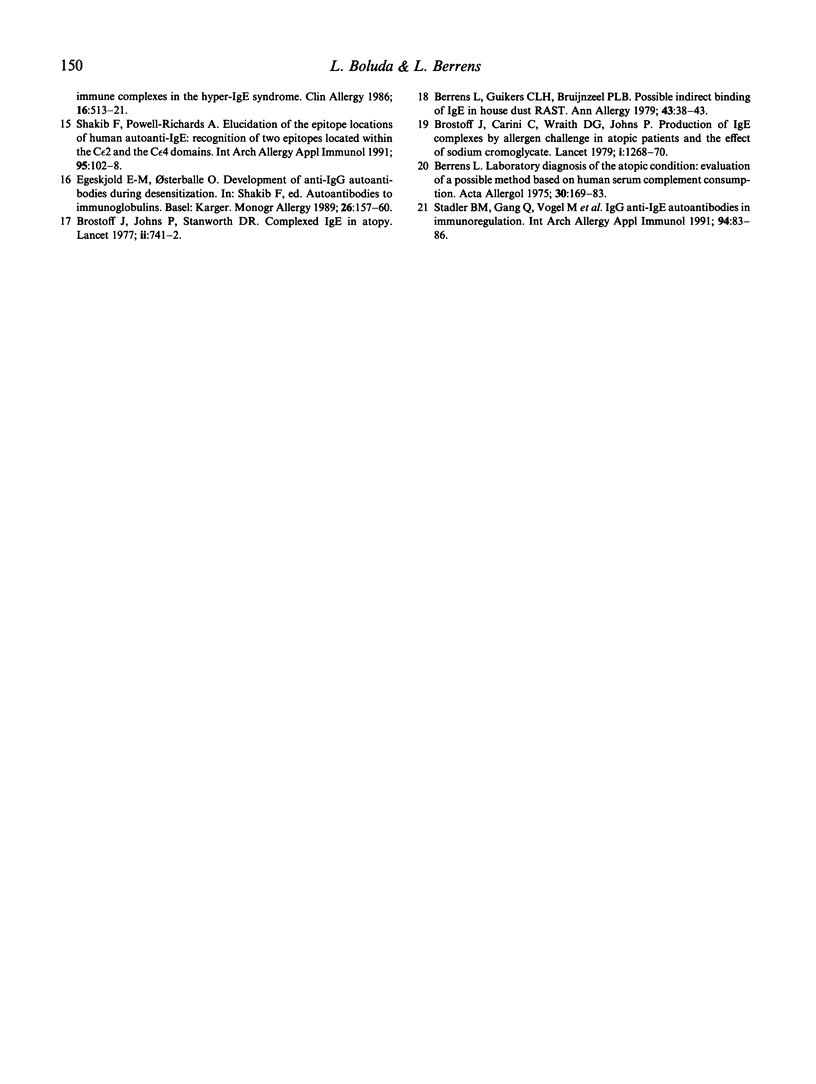
Selected References
These references are in PubMed. This may not be the complete list of references from this article.
- Berrens L., Guikers C. L., Bruynzeel P. L. Possible indirect binding of IgE in house dust RAST. Ann Allergy. 1979 Jul;43(1):38–43. [PubMed] [Google Scholar]
- Berrens L. Laboratory diagnosis of the atopic condition: evaluation of a possible method based on human serum complement consumption. Acta Allergol. 1975 Oct;30(4):169–183. doi: 10.1111/j.1398-9995.1975.tb01340.x. [DOI] [PubMed] [Google Scholar]
- Brostoff J., Carini C., Wraith D. G., Johns P. Production of IgE complexes by allergen challenge in atopic patients and the effect of sodium cromoglycate. Lancet. 1979 Jun 16;1(8129):1268–1270. doi: 10.1016/s0140-6736(79)92229-3. [DOI] [PubMed] [Google Scholar]
- Brostoff J., Johns P., Stanworth D. R. Complexed IgE in atopy. Lancet. 1977 Oct 8;2(8041):741–742. doi: 10.1016/s0140-6736(77)90240-9. [DOI] [PubMed] [Google Scholar]
- Carini C., Fratazzi C., Barbato M. IgG autoantibody to IgE in atopic patients. Ann Allergy. 1988 Jan;60(1):48–52. [PubMed] [Google Scholar]
- Egeskjold E. M., Osterballe O. Development of anti-IgG autoantibodies during desensitisation. Monogr Allergy. 1989;26:157–160. [PubMed] [Google Scholar]
- Inganäs M., Johansson S. G., Bennich H. Anti-IgE antibodies in human serum: occurrence and specificity. Int Arch Allergy Appl Immunol. 1981;65(1):51–61. doi: 10.1159/000232737. [DOI] [PubMed] [Google Scholar]
- Iwamoto I., Nawata Y., Koike T., Tanaka M., Tomioka H., Yoshida S. Relationship between anti-IgE autoantibody and severity of bronchial asthma. Int Arch Allergy Appl Immunol. 1989;90(4):414–416. doi: 10.1159/000235064. [DOI] [PubMed] [Google Scholar]
- Johansson S. G. Anti-IgE antibodies in human serum. J Allergy Clin Immunol. 1986 Apr;77(4):555–557. doi: 10.1016/0091-6749(86)90344-1. [DOI] [PubMed] [Google Scholar]
- Koike T., Tsutsumi A., Nawata Y., Tomioka H., Yoshida S. Prevalence and role of IgG anti-IgE autoantibody in allergic disorders. Monogr Allergy. 1989;26:165–175. [PubMed] [Google Scholar]
- Nawata Y., Koike T., Hosokawa H., Tomioka H., Yoshida S. Anti-IgE autoantibody in patients with atopic dermatitis. J Immunol. 1985 Jul;135(1):478–482. [PubMed] [Google Scholar]
- Paganelli R., Quinti I., Carbonari M., Pontesilli O., D'Offizi G. P., Letta T., Aiuti F. IgG anti-IgE in circulating immune complexes in the hyper-IgE syndrome. Clin Allergy. 1986 Nov;16(6):513–521. doi: 10.1111/j.1365-2222.1986.tb01989.x. [DOI] [PubMed] [Google Scholar]
- Paganelli R., Quinti I. Pathological significance of circulating IgG anti-IgE complexes. Monogr Allergy. 1989;26:184–197. [PubMed] [Google Scholar]
- Quinti I., Brozek C., Wood N., Geha R. S., Leung D. Y. Circulating IgG autoantibodies to IgE in atopic syndromes. J Allergy Clin Immunol. 1986 Apr;77(4):586–594. doi: 10.1016/0091-6749(86)90350-7. [DOI] [PubMed] [Google Scholar]
- Ritter C., Bättig M., Kraemer R., Stadler B. M. IgE hidden in immune complexes with anti-IgE autoantibodies in children with asthma. J Allergy Clin Immunol. 1991 Nov;88(5):793–801. doi: 10.1016/0091-6749(91)90187-s. [DOI] [PubMed] [Google Scholar]
- Shakib F., Powell-Richards A. Elucidation of the epitope locations of human autoanti-IgE: recognition of two epitopes located within the C epsilon 2 and the C epsilon 4 domains. Int Arch Allergy Appl Immunol. 1991;95(2-3):102–108. doi: 10.1159/000235413. [DOI] [PubMed] [Google Scholar]
- Stadler B. M., Gang Q., Vogel M., Jarolim E., Miescher S., Aebischer I., de Weck A. L. IgG anti-IgE autoantibodies in immunoregulation. Int Arch Allergy Appl Immunol. 1991;94(1-4):83–86. doi: 10.1159/000235332. [DOI] [PubMed] [Google Scholar]
- Swainson J. A., Wilson P. B., Doré P., Pumphrey R. S. Evidence for circulating complexes containing IgE in patients with atopic dermatitis. Int Arch Allergy Appl Immunol. 1985;76(3):237–242. doi: 10.1159/000233698. [DOI] [PubMed] [Google Scholar]
- Twena D. M., Marshall J. S., Haeney M. R., Bell E. B. A survey of nonatopic and atopic children and adults for the presence of anti-IgE autoantibodies. Clin Immunol Immunopathol. 1989 Oct;53(1):40–51. doi: 10.1016/0090-1229(89)90099-8. [DOI] [PubMed] [Google Scholar]
- Vassella C. C., de Weck A. L., Stadler B. M. Natural anti-IgE auto-antibodies interfere with diagnostic IgE determination. Clin Exp Allergy. 1990 May;20(3):295–303. doi: 10.1111/j.1365-2222.1990.tb02687.x. [DOI] [PubMed] [Google Scholar]


